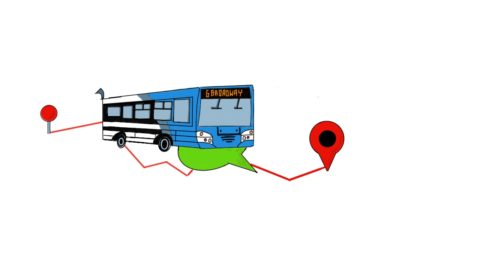The transit system has had a busy year of transformations. After the lockout in 2014, Saskatoon Transit has worked towards improving routes and rider experience for customers. While many students are excited about these improvements, some are increasingly concerned about the current possibility of a transit strike.
Changes to transit services included an increased number of buses going down 8th Street East during peak times and adjustments to most routes. One of the more innovative changes is the real-time GPS tracking that has been installed on most buses. This system has been active on some of the buses for over a year on Google Maps, but it is now available in a mobile friendly version: Transit, an app that students can download from the App Store or Google Play.
The app allows users to find routes that are near their location and also view what times they can catch the bus. Under each route, the app also shows whether a bus is delayed or detoured. An added feature is the alarm function, which can be set to go off well before the bus comes in order to allow customers to make time to walk to their stop.
is delayed or detoured. An added feature is the alarm function, which can be set to go off well before the bus comes in order to allow customers to make time to walk to their stop.
Kate Morrison, a masters student in health science, is currently using the Google Maps real-time tracking.
“I think it is a great app for getting people used to the system … So far, for the most part, it is on time to what it says it will be on time to, and if it’s not, then it’s only a few minutes. And if that’s a huge deal to you, then you may have to revamp your thoughts on using the bus. At least give it a solid effort maybe for a month, and if it doesn’t work for you then you can come up with a plan B,” Morrison said.
Simranjeet Singh, third-year physiology and pharmacology student, shares his views on the real-time tracker.
“The GPS tracking on the city buses is pretty cool and really useful. I like them better than the ‘real life’ map tracking they had earlier which did take some time to refresh. As a student taking the bus to an 8:30 class in the morning three times a week, missing the bus is just one thing less I have to worry about,” Singh said, in an email to the Sheaf.
In addition to this improved technology, Saskatoon Transit has recently been in the public eye due to the union deals that have been going on since 2012. On Sept. 16, a 48-hour strike notice was submitted by Transit to the City of Saskatoon. So far, the strike has taken effect in minimal ways, such as not wearing transit uniforms, but students should be wary of possible service disruptions.
Catherine Gryba, General Manager of the Corporate Performance Department for the city, shared the status of the union deal between the city and the Amalgamated Transit Union.
“Part of the agreement is the wages, which is a 10 per cent increase … The transit union has been asking that wages be on par with other western Canadian cities. All discussions are on pensions … so if we can get the pension part of it resolved, then we’ve got a deal and we can be really happy,” Gryba said.
As a precaution, the University of Saskatchewan issued a warning by email and a Paws announcement to all students, listing various transportation options, such as UCommute — a ride-matching service — cycling to campus and walking. The U of S also warned students to allow for more time and avoid peak transportation hours.
Emmanauel Barker, vice-president operations and finance for the U of S Students’ Union, stated that the university will not arrange a shuttle service as they did during the 2014 lockout, as it was expensive and ineffective. However, he encourages students to choose more active transit options and utilize the UCommute service.
“My main priority is to keep students informed of the transit situation, because that’s what’s most important to them right now,” Barker said. “[Students] need to know if [Saskatoon Transit is] striking, they need to know if there’s a lockout. That’s my priority.”
—
Nykole King
Graphic: Paige Sutherland